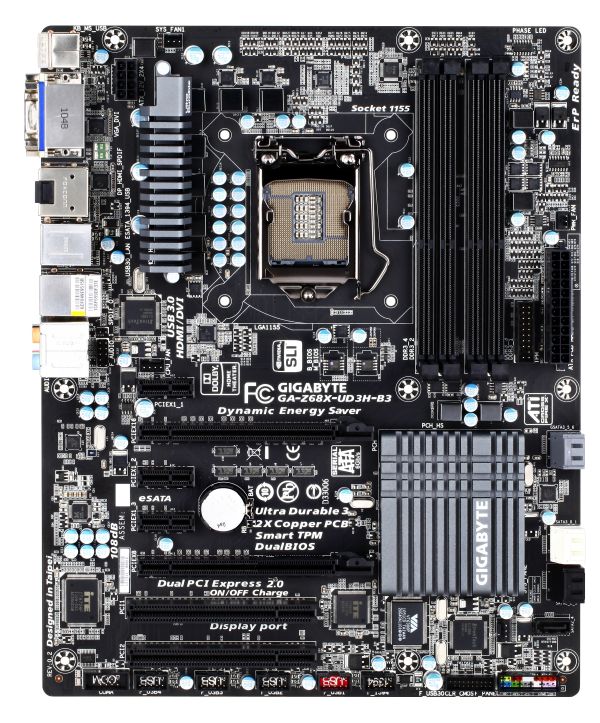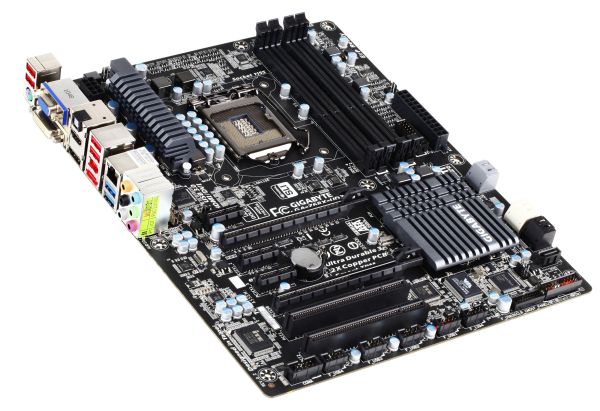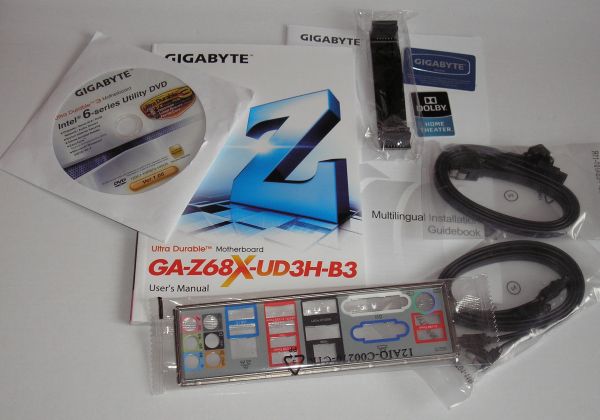Gigabyte Z68X-UD3H-B3 Review
by Brendan van Varik on July 11, 2011 7:01 AM EST- Posted in
- Gigabyte
- Motherboards
- Sandy Bridge
- Z68
Gigabyte has released their Z68 lineup, and today I am going to look at the UD3H - a $170 Z68 board aimed at the mainstream consumer market. The Z68 based motherboards are very similar to the P67 equivalent but they have had a few extra features added. They include Virtu and SSD caching as well as allowing you to take advantage of the GPU built into your Sandy Bridge processor. Is it worth switching from P67 to Z68 for a few extra features? Well, after what I have seen, no, not really.
Visual Inspection
Just like most of Gigabyte's latest range, they have gone with the black and gray theme for this motherboard. In my eyes, it looks very classy and professional.
Gigabyte engineers have used their heads when it comes to the PCIe layout. There’s plenty of room for dual GPU configurations and there’s even a slot for breathing space when utilizing dual slot GPUs. From top to bottom, we have a PCIe 1x, 16x, 1x, 1x, another 16x and two PCI slots. When two GPUs are used, the PCIe 16x lanes run at 8x/8x.
As the PCH heatsink is small and passive, so if dual GPUs are utilized, there may be a heat conductance issue on to the heatsink if there is a lack of airflow. Some aftermarket graphics card coolers vent hot air into the case which will also cause the PCH to warm up if the chassis isn’t vented properly. In fact, when the board was put through its paces on the test bed, the PCH heatsink got very warm to the touch if there was no fan pointed at it.
There is a regular looking I/O panel. The picture above details the selection of connectivity options at the back of this motherboard. A PS/2 port which can be used for either a keyboard or a mouse but not both at the same time. There are a total of four USB 2 and two USB 3 ports, an eSATA 3Gb/s port as well as a FireWire port. The display ports include DVI, VGA, HDMI and a display port. The HDMI and DisplayPort connections carry audio. The single Ethernet port is controlled by the Realtek RTL8111E chip. You can use either the SPDIF or the typical audio connections for your sound.
With regards to the SATA connections, we have three (internal) SATA 3Gb/s connections and four SATA 6Gb/s ports. There is an eSATA port on the I/O of the motherboard which takes the total of SATA 3Gb/s ports to four. Two of the four SATA 6Gb/s ports are controlled by a separate controller – a Marvell 88SE917. These are colored gray and have support for RAID 0 and 1. The rest of the SATA ports are controlled by the Intel Z68 chipset and allow for RAID 0, 1, 5 and 10. You are able to create a RAID array across the SATA 3Gb/s and 6Gb/s ports although the performance may vary (according to Gigabyte).
After comparing to other motherboards, the SATA layout is a tad odd. On most motherboards, you would typically find a row of SATA connectors that are adjacent to each other and then color-coded accordingly. Even though it is only one port which points out of the board and the rest stick out of the side, it looks odd and it doesn’t make sense why this has been done.
A total of four fan headers can be used on this motherboard. There is one for the CPU cooler and three for chassis fans. The CPU fan header is not located in a familiar position as you’d find with other motherboards - it’s in the center board just above the PCIe 1x slot. The two system fans are on opposite sides of the board - one is located just above the VRM heat sink and the other is located just below the PCH heat sink. It would have made more sense to use the header located above the VRM heat sink as the CPU header and vice versa. The PWR fan header is located just above the 24pin power which just like SYS_FAN1 does not allow for speed control.
What is included in the box?
A user’s manual and a multilingual guidebook.
- Driver and utilities DVD
- 2x SATA 6Gb/s cables
- 2x SATA 3Gb/s cables
- A SLi bridge
- I/O shield
- 1x Gigabyte case sticker
- 1x DOLBY case sticker
You do not get many extras with this motherboard. In fact, it is pretty minimalist. Just like other manufacturers, Gigabyte have included the essentials to get your system up and running, and nothing more. If you want more accessories such as the 3.5” front panel with two USB 3.0/2.0 ports or a SATA bracket, you will have to buy the more expensive, higher end models.















70 Comments
View All Comments
versesuvius - Monday, July 11, 2011 - link
Use of plurals for a single entity derives from not knowing which part of that entity the speaker is talking about. It is very curious. I may be wrong but I cannot remember, "IBM have", "Apple have", "Asus have". They are all upstanding members of their trade and craft. But, while Gigabyte is good enough, there is something about it that prevents people from looking at it as a solid entity that deserves a singular reference. In fact, I would go as far as saying that the message is that the unpredictable collection known as Gigabyte has given us this, this time at this price. Gigabyte could as well have priced it $420. As if the pipeline is just cut off at random by a random part of that collection and a product shipped to the market. Not the case with Asus or IBM. Hence, IBM "has", Asus "has".Of course, with regards to the British the plural is a sign of respect. Remember, they are a monarchy, with hereditary parliament membership, and apparently very happy and proud of it. It is absurd to refer to a member of the house of lords in singular terms. Each is a well known clan. Oh, and well respected!!
Andypro - Monday, July 11, 2011 - link
I'm glad someone brought this up. Anandtech editors should edit articles to be consistent.The problem is that American English has a different rule than European English. The American English rule is the correct one. A well-edited scientific site like ArsTechnica recognizes this and edits all of its articles (notice that I used the singular possessive pronoun "its" there) to that end. Anand himself does a nice job with this since he's an American.
Some of the other American writers are being influenced by Wikipedia, British writers, and other sources of confusion. The fact is that number must agree throughout the entire sentence. Logically, the British rule can never accomplish this harmony of number because the corporate entity is always singular. Writers can easily avoid ambiguous constructs by making the subject more specific which helps convey meaning, eg., "Apple's engineers have" or "nVidia's marketing gurus are," etc.
byr - Monday, July 11, 2011 - link
Grammar can be an observance of and more than, rules. Style may be approached. Cautiously."I'm glad someone brought this up. Anandtech editors should edit articles to be consistent."
I'm glad someone brought this up. Anandtech editors should edit articles for consistency.
English writers have and are not considered a source of confusion with the English language any more than writers of other nationality's, Americans included.
Corporations and other entities can be personified perfectly well.
'Apple has pursued it's singular goal' is acceptable as the intention of one entity, further distinctions are made with relevant reference.
'Jobs has a plan for apple"
Two comments above
"Of course, with regards to the British the plural is a sign of respect. Remember, they are a monarchy, with hereditary parliament membership, and apparently very happy and proud of it. It is absurd to refer to a member of the house of lords in singular terms. Each is a well known clan. Oh, and well respected!!"
'The right honorable' is considered the appropriate honorific (they rarely are), it is singular and they, depending on who you ask, are sometimes respected.
British English is adequate until you reach then end of it, then you can use American English if you must. ;)
irreverence - Thursday, July 14, 2011 - link
Byr,I have literally no idea what you were trying to say there. Reading your post made me feel like I had been drugged.
cjs150 - Tuesday, July 12, 2011 - link
"The problem is that American English has a different rule than European English. The American English rule is the correct one. "Look buddy, American English is not correct. Americans cannot spell and if, like me, you have ever had to read a document drafted by an American lawyer, punctuation is not an American strong point but verbal diarrhoea is.
I would say that the only correct form of English is what you call British English, but fact is that English is very flexible. As long as Anandtech are consistent that is fine.
Anyway back to the board. Fan control. Do Gigabyte own shares in one of those companies who make separate fan controller? Because that is the only excuse for such a pitiful on board control
MadMinstrel - Wednesday, July 13, 2011 - link
It's funny how you can determine with such certainty that one rule is correct and another is not. Language is not based in math, it is an arbitrary set of rules driven by speaker inertia. If both variants of the rule set are equivalent in functionality, neither can be considered correct or even superior. In "Gigabyte has/have released a new motherboard", "Gigabyte" could mean either "the Gigabyte corporation" or "the people at Gigabyte". I could argue that the singular variant is illogical because a corporation, an abstract entity, cannot perform any action other than perhaps come into existence. Or I could argue that the plural variant is wrong because fewer people use it. This, of course, would be pointless.marc1000 - Monday, July 11, 2011 - link
nice board, but without speed control on the sys fans, it is less interesting than other options... also very few sata ports for a new product. Gyigabyte is really keeping it "safe and cheap".EnzoFX - Monday, July 11, 2011 - link
One of the great things about UEFI is the faster boot times. Does this hybrid BIOS allow the same? If it's merely a question of cosmetics, then the classic BIOS look would not bother me.paul878 - Monday, July 11, 2011 - link
How was the cpu temperature measured?cyberguyz - Monday, July 11, 2011 - link
... and most motherboard manufacturers are guilty of this, is the fact that they stick the PCIe-1x slots directly below the PCIe-16x slot and leave the outdated PCI slots wide open down at the bottom of the board. It really burns me that these guys don't think of the fact that most new add-in cards are being produced to use in the more modern PCIe-1x and PCIe-4x slots. An example is that I have a PCIe sound card, a high speed network card and a raid controller. Because I also have an Asus GTX 570 Cu II video card (eats 3 slots), I can't use any more than two of these (If I don't mind losing 8x lanes to by x16 card and don't mind snuggling up the shortest one of these PCIe cards really close to the backside of that really HOT video card). Yet I have 2 ncie cool PCI slots sitting out there in the open airstream with no hot components anywhere near them. Video cards are challenging enough to cool without crowding cards within a couple millimeters of them.In order to use all my PCI devices I have to find one of the very few and more expensive motherboards that provide nothing but PCIe slots (No PCI bridge = more expensive - where is the logic in that?)
Grrrr! I have no gripe in mobo makers including a couple PCI slots. There are users out there that will still use them for a few years to come yet. They just need to think that as we progress in technology that these older slots are being abandoned by users in favor of the more modern PCIe versions of their add in cards.